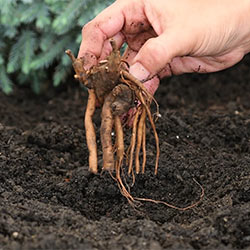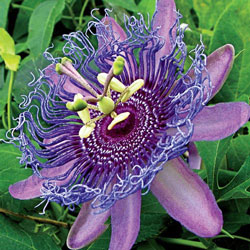What kind of winter care does a Purple Passion Flower need?
Care for Purple Passion Flower vines is very dependent upon climate. These perennials are only cold-hardy in Zones 8, 9 and 10. In most of the United States, passion flower vines cannot survive winter outdoors. So, how do you overwinter a Purple Passion Flower?
Overwintering Purple Passion Flower in Zones 8, 9, and 10:
Lucky snowbirds and year-round residents of the Southern United States won't have any overwintering worries with Purple Passion Flower Vines-there's no real winter in these parts of the United States! After your plants bloom, you can prune them back to maintain shape and get rid of any damaged pieces. Then, simply allow the plants to continue to bloom.
Overwintering Purple Passion Flower in Zones 3, 4, 5, 6, and 7: Bringing the Plants Indoors
If you don't experience warm, tropical weather year-round, you can still enjoy a summer full of purple passion flowers. You'll just need to bring them indoors before cold weather! There are two ways to keep your passion flowers inside over winter: you can keep them in the house, in a sunny window, or you can let them go dormant.
If you're planting in containers, you may want to bring your plants inside and allow them to continue to bloom in the winter. Just keep watering the plants throughout the growing season, and bring them inside before the first frost date. You'll need to place your plants by a sunny window, and continue to provide adequate water. The plants may continue to bloom as if nothing has changed, or their flowering may slow down a bit. You can place the containers outdoors after the air has warmed and the final frost date has gone by. Planting in containers is the easiest way to transition your purple passion vines from outside to inside in the winter.
Overwintering Purple Passion Flower in Zones 3, 4, 5, 6, and 7: Putting Your Plants to Dormancy
If you're planning to keep your passion flowers for another season, and live in a cold climate, you might also consider allowing the plants to go dormant. If planted in containers, your passion vines can remain in those pots. If your plants are in the ground, you'll need to transplant them to a large pot. Cease watering the plants after the blooms have faded, and cut the plants back to just an inch or two of height before late fall. Once the days get shorter, lift the plants and set them in a cool-but not freezing!--location without much light. The plants will go dormant over winter, and can be taken outside after the final frost date.
When is the best time to plant a Purple Passion Flower Vines?
Purple Passion Flower blooms in the summer, and, like many summer bloomers, it prefers to be planted in spring. The best time to plant passion flower is after all threat of frost has passed, remember, passion flowers are not cold-hardy and can't handle frost. Northern gardeners may plant these tropical flowers in containers and overwinter them indoors, or plant them in the ground in spring and lift and pot them in the winter. Regardless, plant your passion flower vines in springtime-we'll send you your plants at the right time to set them in the soil!
What soil and water requirements does a Purple Passion Flower require?
Like other tropical plants, passion flower prefer rich soil that drains well. Add compost or peat most to enrich the soil, and dress it in spring with a granular fertilizer that releases slowly. Passion flowers are surprisingly tolerant of both soil acidity and alkalinity, but they do need good drainage and lots of nutrients.
Purple Passion Flowers are relatively thirsty plants, too. Passion flowers need consistently moist soil, but, again, they don't like soggy feet. Passion vines typically need 1 to 1.5 inches of water each week, so give your passion flower a good soaking twice per week when your garden doesn't receive rain. Keep in mind that passion flowers grown in containers or pots will dry out more quickly than plants grown in the ground.
What type of fruit does the Purple Passion Plant Flower produce when it finishes blooming?
There's nothing quite like the fruit of a passion plant! If you've ever enjoyed passion fruit soda or jelly, you might have an idea of what you're getting into. The flavor is exceptionally sweet, and slightly peachy. The fruit grows to about the size of a hen's egg, and is ripe when it's barely soft to the touch. The core is loaded with seeds, and the fruit can be cored before eating.

























